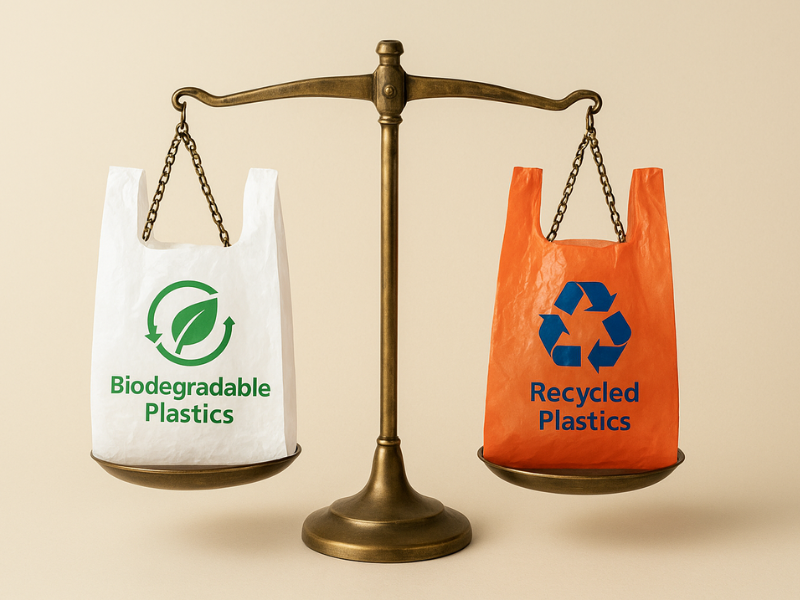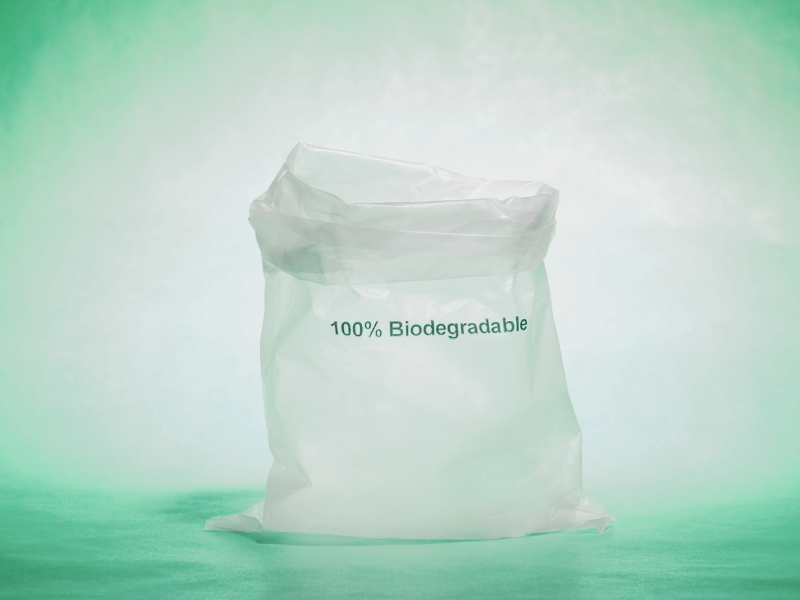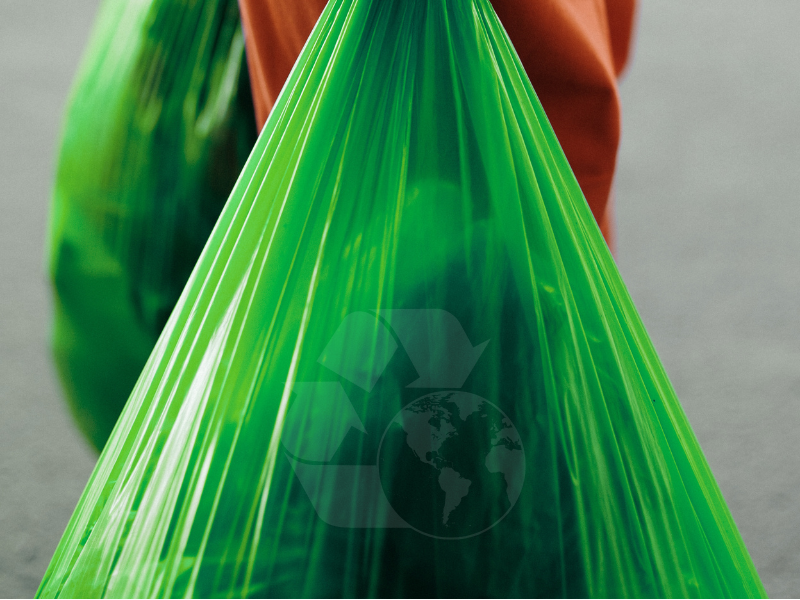Plastic waste has become one of the most pressing environmental concerns of our time, and with so many terms like biodegradable, recyclable, and compostable being used, it is easy to feel confused. Businesses, governments, and consumers are all searching for sustainable solutions, but which option really makes sense? EcoPlastic will help you clarify the key differences between biodegradable and recycled plastics, their benefits, challenges, and practical applications so that you can make informed choices.

Which Option Is Better for Sustainability
1. What Are Biodegradable Plastics?
Biodegradable plastics are designed to break down naturally with the help of microorganisms such as bacteria and fungi. Unlike conventional plastics that can take hundreds of years to decompose, these materials degrade over a shorter period when exposed to specific environmental conditions like heat, moisture, and oxygen.
They can be made from two main sources:
- Biobased biodegradable plastics – produced from renewable resources such as corn starch, sugarcane, or vegetable oils.
- Petroleum-based biodegradable plastics – made from fossil fuels but engineered with additives that enable faster breakdown.
It is important to note that “biodegradable” does not always mean the plastic disappears quickly or harmlessly. The degradation speed depends heavily on the environment. For example, some biodegradable plastics require industrial composting facilities to fully break down, and may not degrade effectively in natural soil or marine environments.
1.1 Advantages of Biodegradable Plastics
- Lower environmental footprint compared to conventional plastics.
- Reduced accumulation of long-lasting plastic waste.
- Can be made from renewable, plant-based resources.
- Suitable for applications like packaging, disposable cutlery, and shopping bags.
1.2 Challenges of Biodegradable Plastics
- Require very specific conditions to degrade fully.
- Can cause confusion among consumers who assume they will break down anywhere.
- Limited infrastructure for large-scale industrial composting.
- Often more expensive than traditional plastics.

What Are Biodegradable Plastics
2. What Are Recycled Plastics?
Recycled plastics are materials that have been collected, processed, and re-manufactured from previously used plastic products. Instead of producing new plastic from raw fossil fuels, recycling gives existing plastics a second life.
There are two primary forms of plastic recycling:
- Mechanical recycling – plastics are cleaned, shredded, melted, and remolded into new items.
- Chemical recycling – plastics are broken down at a molecular level into raw materials that can be reused to produce high-quality plastics.
Recycled plastics are commonly used in packaging, bottles, containers, construction materials, textiles, and even automotive parts.
2.1 Advantages of Recycled Plastics
- Conserves natural resources and reduces reliance on fossil fuels.
- Cuts down the volume of plastic waste in landfills and oceans.
- Supports the circular economy by keeping materials in use longer.
- Generally cost-effective when recycling systems are well established.
2.2 Challenges of Recycled Plastics
- Quality can degrade after multiple recycling cycles.
- Contamination (food residue, mixed plastic types) lowers efficiency.
- Some plastics are difficult or impossible to recycle.
- Requires robust collection and sorting infrastructure.

What Are Recycled Plastics
3. Biodegradable vs Recycled Plastics
While both biodegradable and recycled plastics aim to address the global plastic crisis, they operate in very different ways.
3.1 Origin and Material Composition
- Biodegradable plastics are often biobased and designed to break down naturally.
- Recycled plastics are made from previously used plastic products, keeping existing material in circulation.
3.2 End-of-Life Process
- Biodegradable plastics decompose under suitable environmental conditions.
- Recycled plastics are collected and reprocessed into new products.
3.3 Infrastructure Needs
- Biodegradable plastics may require industrial composting facilities.
- Recycled plastics need efficient waste collection and sorting systems.
3.4 Environmental Impact
- Biodegradable plastics can reduce long-term waste but may release methane or microplastics if not properly degraded.
- Recycling reduces waste accumulation and conserves resources, but does not eliminate plastic’s persistence in the environment.
3.5 Applications
- Biodegradable plastics are ideal for single-use, short-term applications like packaging or utensils.
- Recycled plastics are better suited for durable goods like bottles, containers, textiles, and building materials.
4. Which Option Is Better for Sustainability?
There is no single solution to the plastic problem, and each approach comes with trade-offs.
Biodegradable plastics are valuable in reducing the environmental burden of single-use products, especially when supported by proper composting systems. They work well in closed-loop waste management where collection and composting are guaranteed.
Recycled plastics are essential in building a circular economy by reducing the demand for virgin plastic production. Recycling is more effective when plastic can be collected, sorted, and processed efficiently.
In reality, a combination of both solutions is needed. Biodegradable plastics can replace items that are often littered and hard to recycle, while recycling helps extend the life of plastics that are already in circulation.
5. Practical Applications Across Industries
5.1 Packaging
Food packaging companies increasingly explore biodegradable films, while recycled plastics are common in bottles, containers, and wrapping.
5.2 Retail and Shopping Bags
Biodegradable shopping bags are marketed as eco-friendly, though they require composting facilities to fully break down. Recycled plastic bags help reduce virgin plastic consumption.
5.3 Agriculture
Biodegradable mulch films can replace conventional plastics, preventing soil pollution. Meanwhile, recycled plastics are used in irrigation pipes and storage bins.
5.4 Construction
- Recycled plastics are widely used in roofing tiles, insulation, and piping systems.
- Biodegradable plastics see less use here due to durability concerns.
6. Consumer Awareness and Misconceptions
One of the biggest challenges in sustainable plastics is consumer misunderstanding. Many people assume biodegradable plastics will simply vanish if littered, but this is not true without proper disposal conditions. Likewise, consumers may throw non-recyclable plastics into recycling bins, contaminating the system and making it less efficient.
Education and clear labeling are crucial. Businesses need to communicate transparently about what their products are made of and how they should be disposed of. Governments and organizations also play a role in setting up clear standards and waste management systems.
7. The Future of Sustainable Plastics
Innovation continues to evolve in both biodegradable and recycled plastic industries. Researchers are developing next-generation bioplastics that break down more easily and completely, while recycling technologies are improving to handle a wider range of plastics through chemical processes.
Global policies are also shifting. Many countries are banning single-use plastics, encouraging compostable alternatives, and investing in circular economy models. The combined use of biodegradable and recycled plastics will likely define the next era of sustainable materials.
8. Frequently Asked Questions (FAQ)
8.1 What happens when biodegradable or compostable plastics end up as litter?
If they are left in nature, most biodegradable or compostable plastics do not fully break down. Instead, they may fragment into microplastics, especially in oceans or landfills without the right composting conditions.
8.2 Are recycled plastics biodegradable?
No. Recycled plastics are the same polymers processed for reuse. They extend the material’s life but do not gain biodegradability.
8.3 Which is more sustainable: biodegradable or recycled plastics?
It depends on the application. Biodegradable plastics work best for single-use items if composting facilities are available, while recycled plastics reduce virgin plastic production and support a circular economy.
Conclusion
The global plastic challenge is complex, and no single material provides a perfect solution. Biodegradable plastics offer a promising path for reducing single-use plastic waste, while recycled plastics are critical for conserving resources and extending the life of existing materials. Through this article, Eco has helped you understand more clearly the key differences, benefits, and limitations of both options. In addition, recycled plastic will have a greater price advantage, helping customers save more due to the fact that the price of raw materials is much cheaper than biodegradable materials














